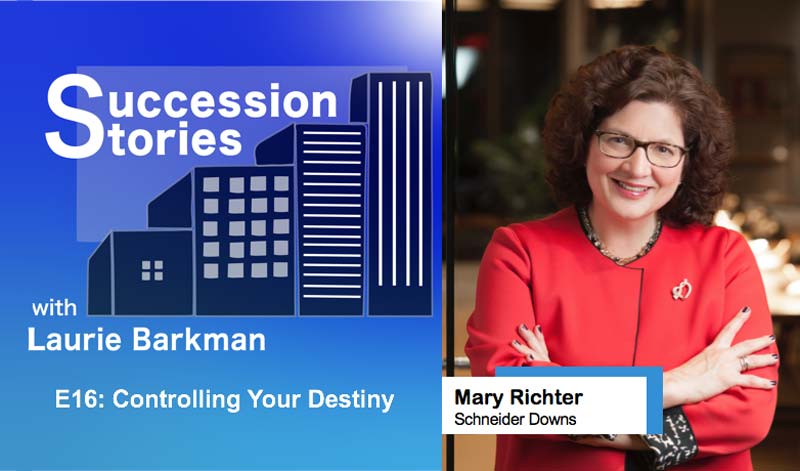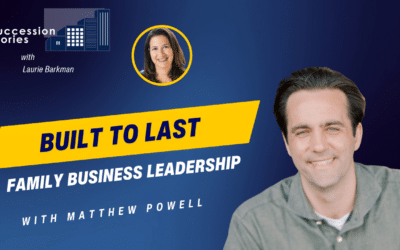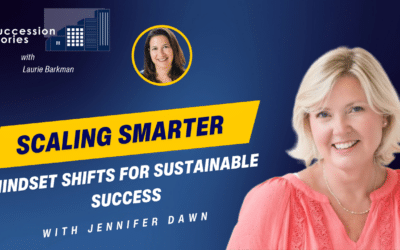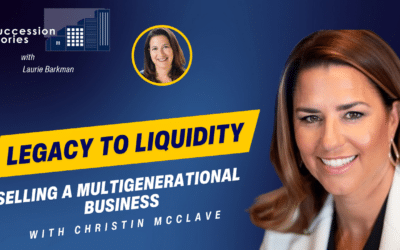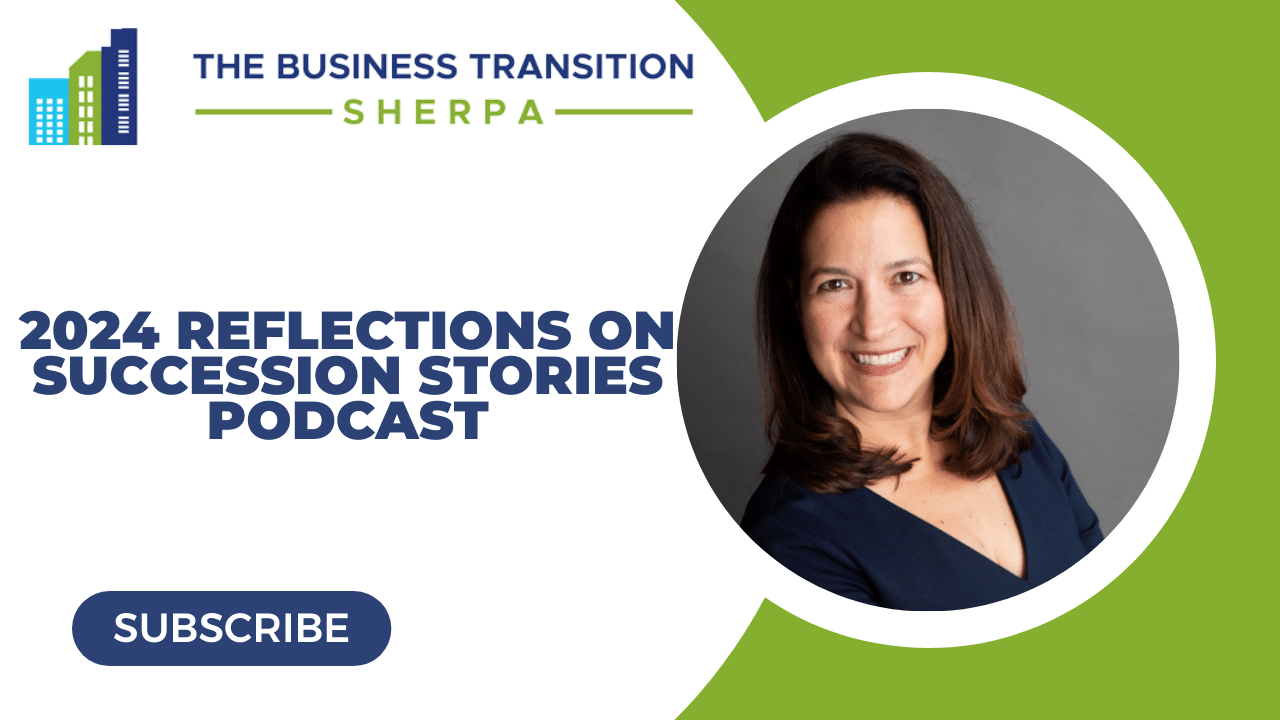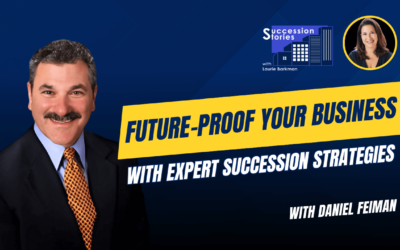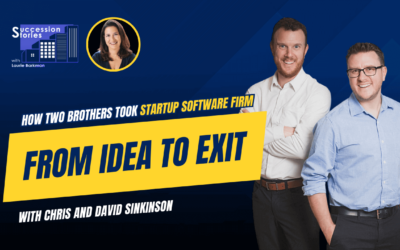Listen to the episode:
Mary Richter is a Shareholder at Schneider Downs, one of the 60 largest accounting and business advisory firms in the United States. Mary was a catalyst for formalizing a practice group for exit planning and succession advisory services to help clients control their destiny. When it comes to succession, it takes a realistic and objective approach to getting the oars in the same direction at the same speed. Mary’s stories about successful transitions and common pain points are helpful if you’re starting to think about the process for your business.
Subscribe to the podcast:
You can subscribe to the Succession Stories Podcast on Apple Podcasts, Google Podcasts, Spotify, Stitcher, or our podcast page.
If you enjoy the episode, please give a 5-star rating and review in Apple Podcasts or your favorite streaming platform to help others find the content.
Show links:
- Mary Richter LinkedIn
- Schneider Downs website
- Schneider Downs Exit Planning & Succession Assessment
- Exit Planning Institute
Full transcript:
Laurie Barkman:
Welcome to Succession Stories, insights for next generation entrepreneurs. I’m Laurie Barkman. I’ve spent my career bringing an entrepreneurial approach to mature companies struggling with change as an outside executive of a third generation, 120 year old company, I was part of a long-term succession plan. Now I work with entrepreneurs, privately held companies, and family businesses to develop innovations that create enterprise value and transition plans to achieve their long-term goals. On this podcast, listen in as I talk with entrepreneurs who are driving innovation and culture change. I speak with owners who successfully transitioned their company and others who experienced disappointment along the way. Guests also include experts in multi-generational businesses and entrepreneurship. If you are a next generation entrepreneur looking for inspiration to grow and thrive, or an owner who can’t figure out the best way to transition their closely held company, this podcast is for you.
Laurie Barkman (00:58)
Mary Richter is a Shareholder at Schneider Downs, one of the 60 largest accounting and business advisory firms in the United States. With her firm, Mary works with many privately held companies and she was a catalyst for formalizing a practice group for exit planning and succession advisory services. When it comes to succession, it takes a realistic and objective approach to getting the oars in the same direction at the same speed. Mary’s stories about successful transitions and common pain points are helpful if you’re starting to think about the process for your business.
Laurie Barkman
Mary, it’s so great you’re here today with me. I really appreciate it. I wanted to tee up to our listeners, how we met. We met a few years ago at a networking event, and you struck me as someone who enjoys lifting up other people. We were a small group, we introduced ourselves and everyone shared one thing that we needed help with, and your responses to everyone were sincere, actionable. And you showed up, so to speak, when I followed up with you and I’m sure when other people did too. So I wanted to thank you for that. And I wanted to thank you for being here today.
Mary Richter (02:13):
Well, thanks Laurie. I appreciate those words. My philosophy is all about connections, because you never know when you can help someone and when they can help you. So great, I’m glad you felt that.
Laurie Barkman (02:25):
I’m excited to talk to you about the work that you do with family businesses. And I wanted to start with talking about you and your firm, Schneider Downs. How long have you been involved with exit planning and succession advisory services?
Mary Richter (02:39):
Well, although we’ve branded it recently, Schneider Downs has been helping businesses – closely held businesses – since its formation in 1956. We actually have clients today who have been with us during our entire existence and helping our clients grow is just in our DNA. We’ve always grown by finding ways to help them- surrounding our clients with services that they need.
Mary Richter (03:00):
Exit planning and succession services is just an extension of what we’ve always done. We actually have a very large base of diverse clients from industry size, complexity, and footprint. And as a result, our service offerings have evolved beyond traditional tax and accounting. We have a retirement plan group, data analytics practice, cyber security technology group, private family office, wealth management, business advisory, and investment banking arms. We also work with public companies so you can see there’s a lot going on in our firm. So while many of our clients start with traditional audit and tax reporting, as we get to know them, we focus on providing planning opportunities to minimize tax, build wealth, improve business processes, assist them in evaluating risks and help them to improve by better utilizing data and technologies. In short, we really try to partner with them to help them grow. And as you can see, succession planning is a natural evolution of that.
Laurie Barkman (04:03):
And the type of work that you do, you did a great job of explaining there’s a big range of things, and you mentioned that the group only recently has been created this exit planning group. But the services you’ve been providing for years. We’ve gotten to know each other, we’ve had conversations off of this call, and you had shared, I thought something really interesting about innovation because one of the things I like to talk about with people who are in traditional businesses – and I would definitely put an accounting firm in that category – I think it’s pretty traditional. And you don’t typically hear about new business creation in a firm like yours, and of course it’s happening. It’s just not top of mind for those of us that are maybe not in the industry or not within that firm. And I wanted you to share just a little bit about that. Can you tell me about the innovation training that your firm has gone through and for you personally and what it’s meant to you and maybe how that brought you to your role in helping to create this new practice group.
Mary Richter (05:09):
Sure. I think we too recognize that accountants are not normally known for being innovative. But we’re trying really hard. We have a bunch of Type A partners who want to do the right thing by the firm, by the clients, by their families, by the employees. We are always looking for different ways of what can we do next. We had our shareholders and C-Suite participate in a two day innovation training. We brought in some consultants and we went through a series of exercises to say, basically, how can we be better? How can we do things better? What else can we be doing? What do we need to do to continue to grow? What other services can we be offering? And that was across the partnerships. The partners in the firm is about 50 partners and a few C-Suite folks. And we just talked about new ways to work both internally and externally.
Mary Richter (06:01):
Everyone is enthused by it, but it’s a little bit hard, right? It’s we had to let go of traditional ideas and get creative. And so out of that, we had already been germinating this idea about succession planning as a service. And we talked about the national and regional demographics, and we knew that there’s a big need. And we knew that we provide a lot of services in that area. So how can we create a multidisciplinary team and a plan and take a holistic look, work holistically for the organization and the owners. And so out of that, that was the start. That was one of the ideas that the partners felt was something we should continue to work on. And so we did. We designed a process to identify, craft, and execute a plan to help clients with their biggest areas of need prior to a sale, prior to an exit, whatever that exit might be, to increase their value.if you’re talking about a closely held business with $20 million in revenue, maybe they’re worth $20 million, maybe they’re worth $50 million. If we can increase that value by working with them, helping them address their issues, why wouldn’t they do that before they sell? I think it’s pretty clear. It’s a no brainer.
Laurie Barkman (07:21):
It’s a great spot to be. And I know there’s a variety of surveys out there. I like to talk about the Exit Planning Institute. I think they do a nice job. One of the surveys that they did not too long ago was measuring how trusted different advisors were. And I think it’s notable that spouse was at the top.
Mary Richter (07:40):
I guess that’s good.
Laurie Barkman (07:43):
That’s good, right! Who do owners talk to and accounting professionals are amongst the top. And that really resonated with me. And I thought about it for our discussion today. And because of the work that your firm is doing, I thought that was really important to underscore. So when you developed your plan and developed the concept, did you talk to business owners themselves to understand their pain points in bringing this service to market?
Mary Richter (08:10):
Yeah. We talked to a lot of different people and in fact, it was in talking with a particular client who’s not really in this demographic. But just having conversations with clients as we like to do, really, he commented there’s so many businesses out there that need help. Well, as a matter of fact, we’re working on that. I think everybody recognizes the baby boomer generation is large. There’s a lot of wealth tied up in that generation and not all of it’s going to go to family members either. They don’t want it. They’re not capable. They’re not there. So there has to be a plan. And one of our partners said at best, during our planning.
“You have a plan. It may not be the plan you want. So let us help you make a plan that you do want. Control your own destiny. Don’t wait for somebody else to make your destiny for you.”
Laurie Barkman (09:04):
Yeah. Control your destiny. Make a plan. There was one of my recent episodes [E09: Avoiding Transition Pitfalls – Jason Seltzer EHD] where I was talking to someone who works with multigenerational businesses and his comment was you might have a plan. It might be in your head, but is that really a plan? If it’s not written down, it’s not well thought through, and it’s not something that we can execute on. And it leads to risks, exposure, if there’s a divorce, if there’s a disagreement, if there’s unfortunately an untimely death, and those things. And so the preparation is super important, but there’s al as you mentioned, various pain points regarding business transitions because they just might not be ready. And I was hoping you could talk about that. What do you see as the biggest pain points related to business transitions?
Mary Richter (09:56):
So there are many of course. I think as you alluded to, people don’t really have a plan or haven’t worked through their plan. That’s one of the biggest issues and really underlying that in most cases is communication. That’s especially true for family businesses where personal dynamics, often intersect what the business dynamics. Sometimes people are in the wrong roles by default. Everyone knows these things, but they don’t really have the courage or they don’t want to hurt somebody’s feelings. So they work around it. Of course, that creates business issues. But when you’re trying to exit that that’s even more exacerbated. Another area that’s often overlooked that I think is crucial is the owner or CEO, or whomever is the selling party, understanding what’s next for them? What’s the owner going to do after transition? It’s simple things to think about. If you don’t own the company, you’re no longer in charge, even if you’re going to work everyday, because you have some type of employment agreement.
Mary Richter (10:54):
Can you handle that? If you’ve been with this business for 40 years and all of a sudden somebody else is telling you what to do? I think we can’t underestimate that. That’s really hard. What do I do with my day? If I’m not going to work, it is crucial, in my opinion, to align those personal, business, and financial goals in this process. If you can’t do that, if you don’t do that, you’ll never find fulfillment and no amount of money is going to make you feel better about that. And lastly, I’ll point out, it’s really difficult for all of us to look in the mirror and point out flaws. We are used to how things are. We overlook issues because we don’t know how to deal with them or they’ve just been there. It’s just the same as every day. A buyer will not have the same approach. So you need to prepare in advance and maximize the business’ value before you exit. Not only will you get a higher sales price, but again, you’ll find fulfillment and you’ll leave a better legacy for your family name, your family members who might continue the community, et cetera.
Laurie Barkman (12:03):
I think that’s a really important point. I just want to underscore about the fulfillment and the legacy and what to do when you’re not in the business anymore. I’ve had some conversations with people about that, and I’m starting to really hone in on it as an opportunity for advisory. That’s one of the things that I’m doing as well as working with people to help them craft their vision. Especially if they’re in a “what’s next” time in their life and selling a company certainly fits that bill. And it’s not an easy thing. I did a webinar for a women’s conference and this was the topic spent an hour talking about the idea of rethinking you. And I can only imagine what that feels like. If you’ve been in a company, your name is on the door, and you have to then separate and rethink, well, what’s next.
Laurie Barkman (12:59):
And certainly family offices and philanthropy. If they’re in a position to be able to pursue those passions is a very fulfilling thing. Maybe they want to go sit on a beach or maybe they want to start another company, or maybe they want to travel around the world. And everyone’s answer is different and unique. What I’ve found is working with people to craft their values, their vision, their mission, their purpose. It may be a pathway to opening their eyes to something they hadn’t considered before. And with this time and money on their hands, that they didn’t have that time probably being the biggest factor. It’s an opportunity to open doors to new things and go on to pursue a path that they never had time to pursue before. And that seems to be a very fulfilling thing for me to work with people on that.
Mary Richter (13:50):
I think that’s a great comment and, and really, people think, oh, I’ll have all this money. My life is great. I’ll be golden. If you don’t know what you’re going to do every day, you’re not. And that third leg, that personal piece – there’s the business, the financial and the personal, that personal piece. If you’re miserable every day, the money’s not going to compensate you for that. Andmost people want to take care of their family, want to take care of the financial needs, but that personal piece is so important and you’re right. Maybe it’s philanthropy, maybe it is sitting on a beach. Maybe you always wanted a boat. That’s fine. But you need to think about those things in advance cause so that you can structure the rest of your life or at least the next year, or whatever it is, in chunks. But you cannot overlook that as a business owner and anybody that’s working with businesses and business owners who want to exit, that is so crucial to consider because your client might have a very monetarily successful transaction, but at the end of the day, they might not be happy. And so how can you help them? The big picture, the whole picture.
Laurie Barkman (15:01):
Yeah, the whole picture. And I’m curious for you, you’ve been doing this a long time, you have a lot of specialty, you’ve talked to a lot of clients. What is something that stands out to you that you wish you had known in this transition process, helping businesses transition, helping owners, that if you were going to rewind and go back to advising on a certain scenario, is there something in particular that stands out? Is it the personal side? Is that what it is? Or is it something else?
Mary Richter (15:32):
I think it’s so hard to answer that. In order to be the best advisor I can be. My job is to be the quarterback, the facilitator, sometimes it’s to be the shoulder to cry on, but sometimes it’s to be the task master. And I think that’s really hard. No one wants to be the mean person in the room, but I think sometimes we all have to be kind of the one that makes people face facts. And as an advisor, you don’t want to get your client mad, but I think trying to do the right thing all the time by the client– that is pointing out their flaws and finding a good way to do that. I think we try not to do that. Not to upset the client, we’ve had long relationships with them.
Mary Richter (16:26):
We don’t want them to feel badly, but I think it’s really important to be as objective as you can, because at the end of the day, you really are doing the right thing for the client and the client will recognize that it may be painful. It may be very painful while you’re going through that. But I think that’s my job. That’s our jobs as advisors is to try and take off that friend hat and put on the advisor hat that’s objective. That to me is really a hard lesson to learn. And it’s like that with all service that we offer, but particularly when it’s something so personal is someone’s business that they’ve spent a lifetime building.
Laurie Barkman (17:15):
I can imagine the emotional side. And you said it’s sometimes you’re the shoulder to cry on. I can understand that might be the case, especially if things have not been going the way that they’ve envisioned. And we’ve all probably heard stories that, hey, it’s been fabulous. Look what happened here. But then there’s stories that, wow, this just did not go the way, it’s funny, people ask me, oh, you have any issues getting people for your show. And I said, no, everyone I’ve talked to has said, yes, the only two people that have said no, are because there were very emotional things that happened to the transition of their family’s company. And otherwise, they’re not ready. They said, yeah, I’m interested, but I’m just not ready. And so that speaks to how raw some of these things are. And it can be because perhaps the value just wasn’t there, something crashed in the deal, or it was a bankruptcy. And it just didn’t go that way. And I was wondering if you could share any stories about business transitions that didn’t quite go the way as expected.
Mary Richter (18:17):
Yeah, I can. I just want to step back. If you think about it, if you look at the statistics…
Only about 20% of small businesses that are up for sale in any one year that sell. So if you think you’re going to be in that 20%, good for you, but think about all the work that has to get there to be in that 20%. Also half of the owners who try to sell their businesses alone fail. The people that do sell, aren’t getting the price they want. They’re only getting 60% to 70% of what they want.
Now, these are statistics compiled from interviews with owners. So they may even be understated it if you think about it that way. The point is, we see that all the time. Clients come to us and say, we got an offer, we’re going to sell.
Mary Richter (19:08):
This is a great deal. It’s a great combination. Everything’s great. We had dinner, we shook hands over it a couple of times, and everybody wants the same thing. The buyer, we’re going to work with them. They want a successful transition. There are really nice people. We can work with them. So newsflash, the buyer is working in their own interest. Why would you not protect yourself? Most people here focus on the purchase price. They they’re like, okay, this is a great price. I can trust the buyer to do everything. You can’t. You cannot do that. You have to spend the time. There are no shortcuts in this business. You need to protect yourself, your employees, your family, whatever your motivation is. You can’t just rely on a handshake. And we’ve seen that a couple of times, this is a great combination.
Mary Richter (20:01):
We’re going to bring somebody in. They’re going to put capital in the business, help us continue to grow. Well, guess what? Now they own the business. They just gave you a hundred million dollars. Do you think that they’re not going to want a say. I mean, that just doesn’t happen. And we’ve seen that several times. It’s important to spend the time, get the right advisors around you, whoever they may be. And more than one. Investment banking is great. We have an arm that does that, but there are other people you should be talking to. Your friends who have sold businesses. They can tell you what didn’t work for them. Other advisors, accountants, attorneys, et cetera. Use the people that you’ve surrounded yourself with for years to help you this, the most important thing you’re going to do for a while, maybe ever.Make sure you take good counsel.
Laurie Barkman (20:55):
Yeah. That’s good insight. And some stories where things really worked well, what stood out? What was part of that formula? Was it surrounding yourself with the really good solid people, having the peer group, something like a YPO, if you’re a President and able to participate in that type of organization.
Mary Richter (21:13):
I will boil it down to a success has different meanings to different people, but in my mind, it’s always about communication. I’ve seen a transitions within family ownership where the lead has passed to different members of the family of two very, very good cases. But they did it thoughtfully over time. They made sure that employee, client, and vendor perception aligned that those people understood who was in charge and that the existing CEO or management who was transitioning out, let go of the reins and empowered the next generation to both stumble and succeed. People have to know that the next person is in charge. Otherwise you’re going to have employees coming to you. You could undermine that. That’s not a good plan. And we’ve also seen in cases where, to your point, maybe the business isn’t really worth what you want it to be worth.
Mary Richter (22:23):
It’s generating cash and it’s positive income, but maybe not a lot of growth. And, we’ve seen exits, people think about what am I going to do? I can’t really sell it and get a lot of money. I can get some money. How am I gonna do this? But I got all these people I want to keep employed. We’ve seen successful transition to ESOPs or employee stock ownership plans. That’s where the employees effectively buy the company and they fund it with the operations of the business. And that could be a win, win. It could be tax beneficial for everyone. It could be a win-win in the right situation. As an owner, you need to think about all the different ways you might be able to exit. It may be family succession, it may be sale to an outright third party. You might need to look internally to your employees.
Laurie Barkman (23:18):
The ESOP is a really interesting option because it sure seems like a win-win, as you mentioned. And if there is a second, or third, or fourth generation being mentored and groomed, then that obviously can be a win too. There might even be a skip generation where a company brings in an outside hire, an executive, until that generation is ready. And you and I probably know a couple of those companies here in the region that have done that successfully and all of those things are great. And as you said, there’s no one formula. So having a plan doesn’t prescribe one solution and working with clients to figure that out, that strategy, is part of it. One of the things that intrigues me is the growth side. One of the things that I like to do is work with clients on their growth strategies. I am always very intrigued by that perspective of, oh, I think my value is here, but I’m here, right? There’s a gap. There’s a disconnect. Can firms get from A to B over time? Have you found that to be the case where if they develop a strategy, develop an action plan, hold people accountable to it, align the teams, get the oars rowing in the same direction that that can make a difference over, let’s say a year or two, or longer?
Mary Richter (24:36):
Absolutely. That’s what we’re trying to do. I’d say not only do we align the oars going in the same direction, but at the same speed. Yes, I mean, business process reviews, right? So looking at operationally, looking at your business, there’s some things that are easy.
- How are your receivables?
- How quickly do you bill?
- Can you produce financial statements and in a reasonable amount of time?
- Do you know what kind of money you’re making?
- Do you understand the difference between EBITDA, which is a term often used for deals, and cashflow.
Those are two different things. If you’re looking for an outside buyer, they’re going to be looking at your earnings, your EBITDA. But if you’re trying to live a lifestyle, you’re looking at cashflow. So those are two different things and we can improve your EBITDA.
Mary Richter (25:25):
We can help you improve your business processes, things like your manufacturing layout does that make sense? Are you running back and forth? These are not novel ideas. These are just good business practices put into action. It’s just about rolling up your sleeves, looking at the things that need to be addressed and just picking them off one by one, starting with the highest need. Maybe sometimes you start with the things that are the easiest, right? If your receivables are bad, if they’re late, get somebody to call clients and say, hey, can you pay us please. It’s not rocket science. It’s just fundamental things that need to be done. In a closely held situation where you may or may not have a good financial backgrounds, this is where having an advisor can really help you.
Laurie Barkman (26:20):
When I was running a company, one of the things that we ended up doing was renegotiating payment terms, and it was worth a lot of money to us. And so, to your point about the operational things, maybe they’re things you’re looking at every day and you just think, oh, this is how it is how it is. And you just need a fresh eye, a fresh perspective, and it can add to the bottom line quite considerably.
Mary Richter (26:44):
And today data tools that are available via data analytics really help point those trends, help show us those trends. It’s important to use the tools that are available to you. There’s a million of them. Or, you can have something designed, but it’s important to just do the fundamentals in your business like cash flow, you can make that cash flow so much better by just reducing your days sales outstanding, or your AR receivables by a small margin. And it all goes to the bottom line.
Laurie Barkman (27:19):
Absolutely. So I want to switch gears a little bit and talk about what you’re seeing in the market regarding the pandemic. There’s an internet meme circulating around EBITDAC, which is Coronavirus. What are you noticing? Are you noticing in conversations with clients that there’s more readiness to sell, less readiness to sell? Just thankful the business is sustainable, and they are just talking about cashflow and the resiliency factors of keeping the business going? Or are you finding that maybe that there’s a change in perspective around that readiness to talk about ownership transition?
Mary Richter (27:56):
Well, what a strange time we’re in. I mean, that’s such an understatement. As you said, looking at business processes, I think people are looking at that more now, right? I mean, renegotiating terms, that’s the first step, right? We’re all, all business owners are trying to make sure we’re collecting our receivables, keeping on top of any issues that might be there. Trying to do the right thing for clients, customers, vendors. But yeah, we’re absolutely seeing people thinking about this more. Right now, I think there’s a little bit of, we don’t know what to do next, because we’re waiting to see what happens. But I think there’s some movement towards movement. Time is not on their side for the baby boomers, right. I mean, they’re aging out. The last three months have probably made them realize that they need to do something soon.
Mary Richter (28:56):
So those that only had the plan in their head are starting to think like, yeah, we probably need to get that on paper now. Or, we’ve seen what happens when you have a transition that wasn’t planned. We’ve just all lived that. There are those that have just said, I have had enough these last three months, I have worked harder than I’ve ever worked before. I’ve had to deal with all this crazy new stuff like social distancing.
Mary Richter (29:22):
And do I need to wear a mask in my own office? I’m done, I’m out. I want out. We do see that. And then we see people that are like, as you said, we’re grateful that we’re holding our own. What do we need to do to continue to grow? We’re so much more fortunate than other companies. They’re ripe for, okay, well, hey, we realized we really didn’t plan for these five things. Now we can look at those things and address them. So again, just good business practice. Again, something that looking at things in a fresh light might have brought something else up from the background. And so now we can work on those things. We also see some willingness in the market to buy, as I said, it’s a little bit unsteady right now, but everybody’s looking for a bargain right now.
Mary Richter (30:13):
There’s companies out that won’t survive. Hey, maybe I can get a deal. PE firms do have some money. The pace of deals, depending on the industry, has been a little bit slow in some cases and in other cases, it hasn’t stopped. Right. It’s kind of hard to do due diligence when you can’t physically go and look at a business. But there is some perhaps uptick or sentiment that there could be some uptick. So we do expect some increased opportunity for exit. But again, that’s if you’re looking to exit, maybe a lot of other people are too. So again, it’s important to be prepared.
Laurie Barkman (30:55)
Yeah. Preparedness definitely is the key. And the readiness makes you prepared, I suppose they go hand in hand. I want to talk about you. What career accomplishment are you most proud of?
Mary Richter (31:10):
Yeah, that’s a hard question. I think what I’m most proud of is what I try to do every day and really my mantra. And I kind of mentioned it is– I try to act by doing what I think is right for the client. And in the end might not be right for me right now, but in the end, it is what I believe is right for the firm and what is right for me. That type of fulfillment for me comes when clients realize I really am trying to work on their best interests and to achieve their goals. I think that extends beyond clients to individuals, mentoring employees and seeing them grow reminds me of how far I’ve come. And really that’s what I feel, I get the most fulfillment from. It’s just those everyday moments that are teaching moments or opportunities to help people.
Mary Richter (32:04):
I think at the end of the day, as I said, when we started, it’s about connection and communication. That will to me, that’ll come back a million times. And then lastly, I’ll say we’re all privileged. I feel it’s my duty to use that privilege to help others, whether it’s helping business owners, whether it’s charitable purposes, helping mentor employees grow the company, you name it. But, it’s kind of incumbent on us to use our privileges to be better and to make other people better.
Laurie Barkman (32:40):
And I think you probably have a give to get mentality, and I would guess that you give more than you get. That strikes me about you.
Mary Richter (32:43):
I don’t know about that. I mean, if I’m operating that way, I’m still doing it. So it must be getting something out of it.
Laurie Barkman (32:49):
Exactly. Did you have a mentor when you were coming through your career?
Mary Richter (32:54):
It’s so funny. I would say I didn’t have a mentor. I had many mentors and I kind of liken it sometimes in the old days when we used to fly frequently, you’d have a single serving friend on the plane next to you. And sometimes I feel like we can have – I don’t want to say single serving mentors – but mentors for a particular area. And so I’ve had lots of those. I’ve been fortunate. For young people that might be, or people that, that are looking in their career for some guidance, I urge you to talk to a lot of people. You learn from everyone, whether it’s a peer, whether it’s your boss, whether it’s a client, a friend you can learn from, from everyone. Take those moments and what can I do with that? What will that teach me, store it away. You might not use it today. You might use it some other time, but keep that in your playbook.
Laurie Barkman (33:53):
Mary, is there anything I should have asked you about, but I didn’t?
Mary Richter (34:00):
So one of the things I’d say is most people don’t know how to start. What do I need to do to think about exiting? Along with others, we have a link on our website that is a free exit planning assessment. So you can go to Schneider Downs website. It’s 22 questions, and it will lead you through a preparedness exercise. Just get your juices flowing. Maybe that gives you some insight and you can figure out what you want to do next. Obviously we’re willing to help you. There are a lot of others, Laurie, you’re great at helping people as well, but I think it’s just something that’s available a tool that people can use to get started.
Laurie Barkman (34:42):
Is there a special link for that, that you can share?
Mary Richter (34:46):
You just go to www.schneiderdowns.com. You can find our exit and business planning, business succession planning, webpage on there. And there’s a link on there for exit planning assessment, easy to find.
Laurie Barkman (35:00):
Great. And we’ll also put that in the show notes. I like to end each episode asking about favorite mantras. I know you’ve shared one already. Do you have another one specific to entrepreneurship?
Mary Richter (35:15):
I have a favorite mantra. It’s being an entrepreneur. We all are in some regard. We face new challenges every day. Some days are great, others, not so much, maybe a little challenging. But those hard times get us through that’s part of life and that’s what leads to a fuller life. So my favorite quote of all time for entrepreneurship and just life is from Winston Churchill.
“Success is not final. Failure is not fatal. It is the courage to continue that counts.” – Winston Churchill
Laurie Barkman
The courage to continue. And he was a great man. Certainly knew a lot of courage. Mary, thank you so much for being here. Thank you for talking about Schneider Downs, your career, the things that keep you motivated, and providing great service for your clients. It was great to talk to you today.
Mary Richter
Thanks, Laurie. It’s my pleasure. And I appreciate all you do for your clients.
Laurie Barkman
Thank you.
Laurie Barkman (36:12):
Thanks for listening. I hope you enjoyed the episode. Three things before you go:
1. Follow Succession Stories Podcast on LinkedIn. Join the community to share feedback, submit questions, and ideas for future episodes.
2. If you want to develop a roadmap for your business to innovate, transition, or grow, let’s talk.
3. Hit 5-stars in Apple Podcasts and share with friends on GoodPods if you enjoyed the episode.
Thanks again for tuning in!

